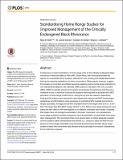Files in this item
Standardising home range studies towards improved management of the critically endangered black rhinoceros
Item metadata
| dc.contributor.author | Plotz, Roan D. | |
| dc.contributor.author | Grecian, W. James | |
| dc.contributor.author | Kerley, Graham I. H. | |
| dc.contributor.author | Linklater, Wayne L. | |
| dc.date.accessioned | 2017-05-09T11:30:15Z | |
| dc.date.available | 2017-05-09T11:30:15Z | |
| dc.date.issued | 2016-03-30 | |
| dc.identifier | 249951421 | |
| dc.identifier | 0d146326-5cb7-4142-93f8-647ffe648aa8 | |
| dc.identifier | 84977604752 | |
| dc.identifier.citation | Plotz , R D , Grecian , W J , Kerley , G I H & Linklater , W L 2016 , ' Standardising home range studies towards improved management of the critically endangered black rhinoceros ' , PLoS One , vol. 11 , no. 3 , 0150571 . https://doi.org/10.1371/journal.pone.0150571 | en |
| dc.identifier.issn | 1932-6203 | |
| dc.identifier.other | ORCID: /0000-0002-6428-719X/work/32706774 | |
| dc.identifier.uri | https://hdl.handle.net/10023/10729 | |
| dc.description.abstract | Comparisons of recent estimations of home range sizes for the critically endangered black rhinoceros in Hluhluwe-iMfolozi Park (HiP), South Africa, with historical estimates led reports of a substantial (54%) increase, attributed to over-stocking and habitat deterioration that has far-reaching implications for rhino conservation. Other reports, however, suggest the increase is more likely an artefact caused by applying various home range estimators to non-standardised datasets. We collected 1939 locations of 25 black rhino over six years (2004–2009) to estimate annual home ranges and evaluate the hypothesis that they have increased in size. A minimum of 30 and 25 locations were required for accurate 95% MCP estimation of home range of adult rhinos, during the dry and wet seasons respectively. Forty and 55 locations were required for adult female and male annual MCP home ranges, respectively, and 30 locations were necessary for estimating 90% bivariate kernel home ranges accurately. Average annual 95% bivariate kernel home ranges were 20.4 ± 1.2 km2, 53 ±1.9% larger than 95% MCP ranges (9.8 km2 ± 0.9). When home range techniques used during the late-1960s in HiP were applied to our dataset, estimates were similar, indicating that ranges have not changed substantially in 50 years. Inaccurate, non-standardised, home range estimates and their comparison have the potential to mislead black rhino population management. We recommend that more care be taken to collect adequate numbers of rhino locations within standardized time periods (i.e., season or year) and that the comparison of home ranges estimated using dissimilar procedures be avoided. Home range studies of black rhino have been data deficient and procedurally inconsistent. Standardisation of methods is required. | |
| dc.format.extent | 17 | |
| dc.format.extent | 987312 | |
| dc.language.iso | eng | |
| dc.relation.ispartof | PLoS One | en |
| dc.subject | QH301 Biology | en |
| dc.subject | QL Zoology | en |
| dc.subject | DAS | en |
| dc.subject.lcc | QH301 | en |
| dc.subject.lcc | QL | en |
| dc.title | Standardising home range studies towards improved management of the critically endangered black rhinoceros | en |
| dc.type | Journal article | en |
| dc.contributor.institution | University of St Andrews. School of Biology | en |
| dc.contributor.institution | University of St Andrews. Sea Mammal Research Unit | en |
| dc.contributor.institution | University of St Andrews. Scottish Oceans Institute | en |
| dc.identifier.doi | https://doi.org/10.1371/journal.pone.0150571 | |
| dc.description.status | Peer reviewed | en |
| dc.identifier.url | http://journals.plos.org/plosone/article?id=10.1371/journal.pone.0150571#sec015 | en |
This item appears in the following Collection(s)
Items in the St Andrews Research Repository are protected by copyright, with all rights reserved, unless otherwise indicated.

